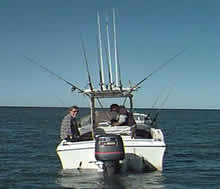01: 3D Lure Pattern Concept
Between The Lines - Ch 09: Running Lures
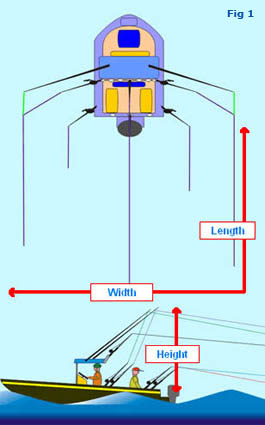 The approach to setting up a boat to troll lures can be thought of as a three-dimensional design. Earlier this concept was introduced in reference to selecting lures for a trolling pattern. Here it was noted the set-up for trolling lures need consider height, width and length, all of which enhance the ability to run several types of lures in the various positions within the lure spread. (Fig 1) This is apart from the fact that having lines set at a different height, width and length make it easier to run many lures and still turn the boat with a low risk of tangling them. The approach to setting up a boat to troll lures can be thought of as a three-dimensional design. Earlier this concept was introduced in reference to selecting lures for a trolling pattern. Here it was noted the set-up for trolling lures need consider height, width and length, all of which enhance the ability to run several types of lures in the various positions within the lure spread. (Fig 1) This is apart from the fact that having lines set at a different height, width and length make it easier to run many lures and still turn the boat with a low risk of tangling them.
In this section, we’ll take the concept further by exploring the considerations that should be taken into account when setting up a boat that will at times troll lures. These considerations are regardless of the size of the boat. HeightThe higher the towing point you have available the better, as it will increase your ability to run lures at a high angle to the water. The higher this angle the more aggressive, the lower the more sedate, the action of the lure. (Fig 2) Consider all of the components that achieve height as being adjustable. For example, when using outriggers the clip or tagline may be run right at the top of the rigger (Fig 3) or anywhere on the length of the halyard which means the entire length of the outrigger can be used for adjustment of height. (Fig 4) When we consider height in lure patterns, we normally assume we are referring to outriggers and shotgun poles. There are however many alternative methods of adjusting height, some of which are:
Rocket launchers, normally used for storing rods, can be handy for running rods if there is some forethought in their design, ensuring that they are strong enough and that an angler can reach and remove a rod loaded with a fish on the end of it.
If the face of the lure is continually being pulled out of the surface, the angle of entry or height is too high. It is too low if the lure seems to drag with the leader lying in the water as the lure breathes. An increase in angle or height can to some extent compensate for heavy leaders which would otherwise hinder a lure's performance. Width
The ability to alter the width of the pattern is also used to position lures on windy and rough days, enabling you to separate them to lessen the chances of tangles. Outriggers are once again the most common method of Length: The greatest versatility of available adjustments is needed when trolling in calm water which is one of the reasons that planning, practising and viewing the wash and checking set-up is done inside a bay or harbour in protected waters.
|





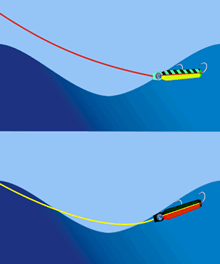
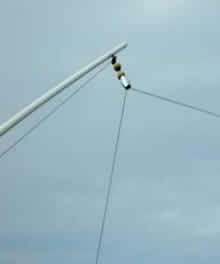
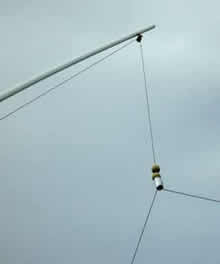
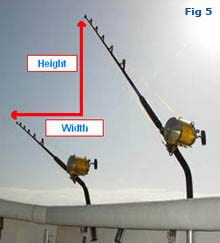 Apart from outriggers, most lines are run directly off the rod tip with the height dictated by the length of the rod and the rod holders they sit in. As a further fine adjustment, the entire length of rod can be used by running rubber bands from the rod or reel to the line. This is also a great way to stop line f
Apart from outriggers, most lines are run directly off the rod tip with the height dictated by the length of the rod and the rod holders they sit in. As a further fine adjustment, the entire length of rod can be used by running rubber bands from the rod or reel to the line. This is also a great way to stop line f licking around the rod tip if lures are bouncing out of the water in rough weather. Mini taglines using clips or rubber bands can also be run from anywhere it can be connected to the boat such as a cleat.
licking around the rod tip if lures are bouncing out of the water in rough weather. Mini taglines using clips or rubber bands can also be run from anywhere it can be connected to the boat such as a cleat.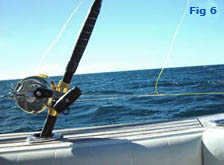 Apart from enabling you to run more lures, there are several subtleties to consider that gives the ability to adjust where the lures can be run in a pattern relative to. On calm days there is nothing to hide the lure's baggage, that is, its leader, hooks, swivels etc as it silhouettes against a mirror surface. It is advantageous in these conditions to improve presentation by running lures on the edge of the wash that will camouflage the leader, swivels and the like but still allow the lure to be clearly seen. (Vid 1)
Apart from enabling you to run more lures, there are several subtleties to consider that gives the ability to adjust where the lures can be run in a pattern relative to. On calm days there is nothing to hide the lure's baggage, that is, its leader, hooks, swivels etc as it silhouettes against a mirror surface. It is advantageous in these conditions to improve presentation by running lures on the edge of the wash that will camouflage the leader, swivels and the like but still allow the lure to be clearly seen. (Vid 1)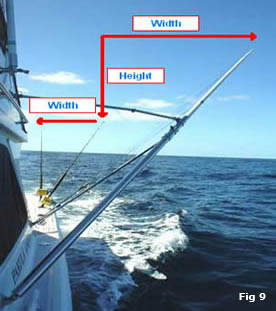 spreading lures, adjustable through their full length and rod holder positions (Fig 9) and angles, angling the end rod holders on rocket launchers (Fig 10) and getting some angled inserts for the normal rod holders in the gunwale. (Fig 11)
spreading lures, adjustable through their full length and rod holder positions (Fig 9) and angles, angling the end rod holders on rocket launchers (Fig 10) and getting some angled inserts for the normal rod holders in the gunwale. (Fig 11)